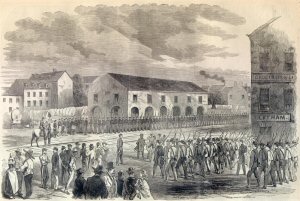
Northern Virginia, locally referred to as NOVA or NoVA, comprises several counties and independent cities in the Commonwealth of Virginia in the United States. The region radiates westward and southward from Washington, D.C., the nation's capital, and has a population of 3,257,133 people as of 2023 U.S. Census Bureau estimates, representing of a third of the state's total population. It is the most populous region in both Virginia and the regional Washington metropolitan area.

The Battle of Aldie took place on June 17, 1863, in Loudoun County, Virginia, as part of the Gettysburg Campaign of the American Civil War.
The Bull Run Mountains are a mountain range of the Blue Ridge Mountains in northern Virginia in the United States. Located approximately 20 miles (32 km) east of the main chain, across the Loudoun Valley. The Bull Run Mountains, together with Catoctin Mountain in Virginia and Maryland, make up the easternmost front of the Blue Ridge.

The 33rd Virginia Infantry Regiment was an infantry regiment raised in the Commonwealth of Virginia for service in the Confederate States Army during the American Civil War. It was a part of the famed "Stonewall Brigade," named for General Stonewall Jackson.

Ashby Gap, more commonly known as Ashby's Gap is a wind gap in the Blue Ridge Mountains on the border of Clarke County, Loudoun County and Fauquier County in Virginia. The gap is traversed by U.S. Route 50. The Appalachian trail also passes across the gap.

The Loudoun Valley is a small, but historically significant valley in the Blue Ridge Mountains located in Loudoun County in Northern Virginia in the United States.

U.S. Route 50 is a transcontinental highway which stretches from Ocean City, Maryland to West Sacramento, California. In the U.S. state of Virginia, US 50 extends 86 miles (138 km) from the border with Washington, D.C. at a Potomac River crossing at Rosslyn in Arlington County to the West Virginia state line near Gore in Frederick County.
Loudoun County, Virginia, was destined to be an area of significant military activity during the American Civil War. Located on Virginia's northern frontier, the Potomac River, Loudoun County became a borderland after Virginia's secession from the Union in early 1861. Loudoun County's numerous Potomac bridges, ferries and fords made it an ideal location for the Union and Confederate armies to cross into and out of Virginia. Likewise, the county's several gaps in the Blue Ridge Mountains that connected the Piedmont to the Shenandoah Valley and Winchester were of considerable strategic importance. The opposing armies would traverse the county several times throughout the war leading to several small battles, most notably the Battle of Ball's Bluff.
Company D, 2nd Virginia Infantry, locally designated the Berkeley Border Guards, was an antebellum Virginia militia company and then a company of the 2nd Virginia Infantry, a Confederate infantry unit during the American Civil War.

The city of Winchester, Virginia, and the surrounding area, were the site of numerous battles during the American Civil War, as contending armies strove to control the lower Shenandoah Valley. Winchester changed hands more often than any other Confederate city.
The 24th Georgia Infantry Regiment was an infantry regiment in the Confederate States Army during the American Civil War. The regiment was part of Thomas Cobb's brigade at the Battle of Fredericksburg.

William Thomas Poague was a Confederate States Army officer serving in the artillery during the American Civil War. He later served as Treasurer of the Virginia Military Institute.

The 4th North Carolina Infantry Regiment was a Confederate States Army regiment during the American Civil War, active from 1861 until the war's end in April 1865. Ordered to Virginia, the unit served in General Winfield S. Featherston’s, George B. Anderson’s, Stephen D. Ramseur’s, and William R. Cox’s Brigade. Its field officers were Colonels George B. Anderson, Bryan Grimes, Edwin A. Osborne, and James H. Wood; Lieutenant Colonels David M. Carter and John A. Young; and Majors Edward S. Marsh and Absalom K. Simonton. It was nicknamed "The Bloody Fourth" after the high rate of casualties at the Battle of Seven Pines.
5th Maine Light Artillery Battery was an artillery battery that served in the Union Army during the American Civil War.
Battery G, 1st Rhode Island Light Artillery Regiment was an artillery battery that served in the Union Army during the American Civil War.

The 110th Pennsylvania Volunteer Infantry was an infantry regiment that served in the Union Army during the American Civil War.
The 2nd New Jersey Infantry Regiment was an infantry regiment in the Union Army during the American Civil War.
The 4th New Jersey Infantry Regiment was an infantry regiment in the Union Army during the American Civil War. 4th New Jersey Volunteer Infantry Regiment lost 5 officers and 156 enlisted men killed or mortally wounded and 2 officers and 103 enlisted men to disease during the Civil War. Col. J.H Simpson helps lead the 4th N.J through the hardship's.
Battery "G" 1st Regiment of Artillery was a light artillery battery that served in the Union Army during the American Civil War.

The 1st Rockbridge Artillery was a light artillery battery in the Confederate States Army during the American Civil War.











